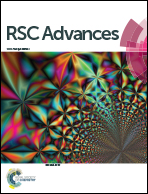Growth temperature-dependent performance of planar CH3NH3PbI3 solar cells fabricated by a two-step subliming vapor method below 120 °C
Abstract
Using an extremely simple but promising two-step sequential subliming vapor deposition method, we grow high-quality perovskite CH3NH3PbI3 films with a uniform and continuous surface coverage. The perovskite film morphology and growth orientation can be well controlled by the growth temperature. The temperature influence on the power conversion efficiency (PCE) and the current–voltage hysteresis of the Spiro/CH3NH3PbI3/TiO2 P-i-N planar film solar cells is also investigated. Furthermore, a novel solvent annealed PCBM film was introduced between the TiO2 compact layer and perovskite active layer, which not only reduces the J–V hysteresis obviously but also enhances device performance. After optimization of the fabrication temperature and device structure, it was found that the PCEs of the solar cells fabricated at 120 °C on glass and flexible PET substrates can reach 15.59% and 7.62%, respectively. This promising approach provides a way to construct low-cost and large-area perovskite cell devices.


 Please wait while we load your content...
Please wait while we load your content...